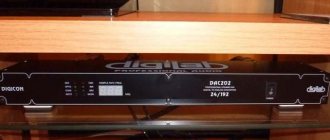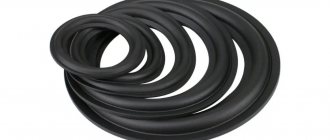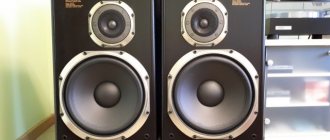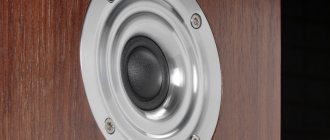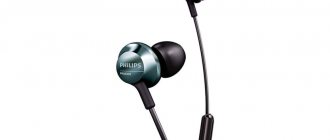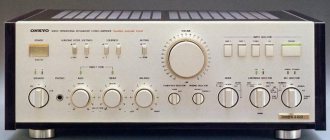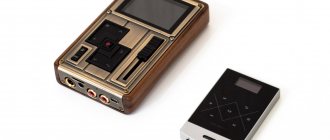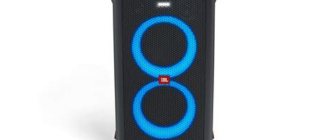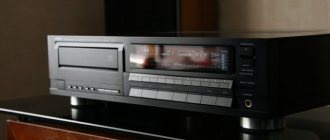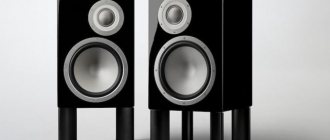Acoustics Diatone DS-66ex reviews
I have long dreamed of having a good speaker system. Previously, back in the 80s, I already had a similar system. At that distant time it was not possible to acquire anything worthwhile. Basically, the trade brands Amphiton and Radiotekhnika dominated the Soviet market. And even then they were quite expensive. But after saving some money I bought Amphytons. How happy I was at that moment. In addition, the thought that they do not meet the standards did not appear to me.
Later, more advanced Japanese equipment began to appear on our Soviet market. My eyes were wide open from such diversity. As a result, the Amphiton speakers were sold. But I bought a Japanese music center Panasonic. But the sound quality left much to be desired. From that moment my search for normal equipment began. Japanese stereos are beautiful and flashy, but none of them produced the kind of surround sound I'd heard before. How I regretted selling the Amphitons.
Time passed and the understanding of good sound came. The search began for more serious equipment. At the slightest opportunity, I listened to the sound of various brands of audio systems. I consulted with experts in these matters. I listened to different opinions and read a lot of literature about the Japanese domestic market. It was the study of the Japanese domestic market that made me pay attention to the Diatone DS speaker systems.
This brand will turn 75 years old in September. Mitsubishi's audio division, Diatone, was closed back in 1999. The Diatone brand is the most legendary and one of the most popular in Japan. This information made me pay attention to this system.
There were a great variety of acoustic systems. But my choice fell on the Diatone DS-77Z series. There are many reasons and advantages of this system. But as it turned out, the price for them is huge even in modern times. Based on this problem, the search began for a cheaper option with similar sound and parameters. A long search for price and quality was crowned with success.
I purchased the Diatone DS-66ex acoustics through friends at a Japanese auction. They were produced only in the Japanese domestic market. At the time of production, their cost was 49,800 Yen per piece. Speakers manufactured in 1986. I will not describe to you all the technical characteristics of this system; there are already plenty of them on the Internet. Let me just say that I am happy to have wonderful equipment and equally wonderful sound at home. By the way, in price they are of course inferior to the Diatone DS-77Z series, but you will hardly feel the difference in sound.
Diatone DS-2000 – impressions, comparisons
Diatone (aka Mitsubishi) is known to many audio enthusiasts primarily for its speaker systems. The line of acoustics stands out for its high sound quality, even in relatively affordable models.
My system used high-end Diatone DS-1000 speaker systems for quite a long time. This is an excellent acoustics with transparent sound, naturalness and high speed.
Thanks to the closed box form factor, the Diatone DS-1000 sounds very clearly, without humming. There is also a small minus - with a relatively small size (this acoustics is smaller than, for example, the popular Diatone DS-77Z), it cannot provide such depth of bass as can be heard on 77s (although 77s are far from records in this regard), and also smaller in sound compared to acoustics that are lower in rank (I’m still talking about 77). But the resolution, richness, sparkle of sound, endings right down to the mica creak - this is, of course, the entire advantage of the sound of the Diatone DS-1000.
Later, circumstances led to the fact that the Diatone DS-1000 was replaced by Yamaha NS-1000M monitor-type speaker systems, which literally shocked with significantly greater transparency and space in the sound.
Just huge beryllium domes on the midrange and high frequencies really create magic. You listen and don’t believe that sound of such transparency and resolution is even possible. This “wow” effect is so strong that you remain under its influence for a certain amount of time.
But later, when the ability to think rationally returns, you realize that the Yamaha NS-1000M has certain limitations. Of course, this is primarily the bass; it is so not deep that it can seriously upset you. An attempt to increase it with an equalizer will show that it is also somewhat amorphous and not clear enough compared to Diatone acoustics.
And in the end, you come to the conclusion that the Yamaha NS-1000 simply sounds divine vocal compositions in a stick-to-stick arrangement with two strings, jazz with wind instruments. But rock, and especially fast metal, not only does not sound, but generally looks extremely dull and unconvincing.
Given the choice, I admired the jazz sound of the Yamaha NS-1000 and preferred the simpler Diatone DS-77Z, which produced a more emotional, juice-filled sound across all genres, not just some.
Those. It can be stated that the Yamaha NS-1000 is simply an amazing acoustic system in terms of sound quality, but unfortunately it is genre-dependent. I think - these are all echoes of the monitor - reduced bass in the lower register makes it possible to show the middle in unrealistic detail, but this also leads to a certain brightness. There is a way out - you can reduce the intensity of the mid-high frequencies on the speakers - this will strengthen the low frequencies, but such amazing clarity will fade a little.
Well, you understand, there is no ideal.
In the end, I came to the conclusion that the Diatone DS-2000 might be the best choice for me personally. They are larger in size than the Diatone DS-1000 and, despite all the beauty of the sound of the Diatone DS-1000, they should give solidity to the lower register due to the larger size of the cabinet and speakers.
You might say that perhaps an even better choice would be the Diatone DS-3000. I had such acoustic systems several years ago, but, honestly, I didn’t fully appreciate them. In the midrange there is a large aramid mug added, which brings its own vision of the sound, and as I understand it, my ears have become attached to the sound of titanium or tiboron (boron-titanium) domes. Perhaps now I could change my mind, but now I don’t have that opportunity.
And systematically I installed Diatone DS-2000 into my system. Let me remind you that before the Diatone DS-2000, my system included the Diatone DS-1000, Yamaha NS-1000M and Diatone DS-77Z. Having literally removed the Diatone DS-77Z from its pedestals, a day later I installed the Diatone DS-2000 in the same place - visually beautiful speakers, with shining rims and monumental domes.
Diatone DS-2000 was received in amazing condition, no traces of corrosion typical of Japan on the rims or domes, shiny noble veneer.
Diatone DS-2000 are top-end speaker systems. They were produced in 1985 at a price of 336,000 yen per pair (according to the CPI index - see the calculator on the website - now they would cost at least $3,100, but in fact you still need to multiply by 1.7, since the consumer basket index and audio are not same). Diatone DS-2000 appeared after Diatone DS-1000 and in it the developers decided that the time had come for deeper bass, despite the same form factor.
In size, by eye, I did not notice any differences from the size of the Diatone DS-77Z - about the same, but darker in color, almost cherry.
The dimensions of the 77Z and 2000 are very close, with a difference of 1-3 cm in favor of the 2000. The woofer of the 77z is even larger by 1 cm. The midrange is also the same, but different speakers are used here, and the comparison is inappropriate. In the 77Z, the midrange driver is a hybrid of a titanium cone and an aramid cone bowl around it, which is suspended on a tangential suspension. In the Diatone DS-2000, the midrange driver is a 6 cm dome made of pure titanium on which boron foam is sprayed. This approach made it possible to completely suppress any parasitic sibilance in titanium and give an extremely natural sound to vocals.
SOUND OF DIATONE DS-2000
If you heard high-end Diatones before the 90s (1000,2000, HR, HRX), then everything will be recognizable to you - these are still the same Diatones capable of infecting with their presentation. The saxophone sounds amazing, it scratches you, it's alive. The vocals are nice and beautiful. The drums are very fast and clear.
First impressions of the Diatone DS-2000 are full-bodied sound. Thick thick bass, as expected. Hey guys, I'm not talking about the liver-massaging bass like in the Soviet C90, but this is a really good and dense Diaton bass in the ZYa form factor.
Probably for the same reason - they added more bass, compared to the Diatone DS-1000, and the swings swayed, the mids and highs became less pronounced.
Therefore, the feeling is that Diatone DS-2000 is thicker in sound, but less bright, compared to Diatone DS-1000 or Diatone DS-77Z.
1000 and 77z sound brighter, 2000 is a little more muted in HF. But the bass depth of the 2000 clearly surpasses, of course, the 1000 model and is slightly ahead of the 77Z.
One can assume that the Diatone DS-2000 will now trample the “cheap” 77s, with their price tag of 120,000 yen (~$1200), but, guys, it was not for nothing that the descendants absorbed the top technologies of previous years. The first impression is that the sound is very similar to the 77s. Same scale, fairly high transparency.
After a while, you can feel the greater refinement and ideality of the sound of the 2000s, and even later, after an hour of listening, you can finally understand what the difference is. Those. The 77s are acoustics of such a high class that without careful listening you cannot immediately say - ahaha, but it doesn’t have enough resolution or speed - and both models have enough resolution and speed.
The difference lies in the fantastic microdynamics - you listen to the Diatone DS-2000 and suddenly realize that many of the sounds have claws that scratch you. Many sounds have a silvery and creaky mica in the vocal or string sound that ends up poking at you.
You listen to the Diatone DS-2000 and just know that this is a top-class acoustics, in which everything is done for sound and done very cool.
DIATONE DS 77 modernization
After listening to DIATONE and comparing with other acoustic systems, it was decided to upgrade one pair of DIATONE DS 77 HRX ; it was impossible to put up with such a sound.
Figure 1. Speaker system DIATONE DS 77 HRX
Click on the picture to enlarge it
Having disassembled the acoustic systems and removed the filter from the depths of the acoustics, a crossover diagram was drawn up. The acoustic system inside is well made, damped with technical wool and there are spacers. The walls of the acoustics are made of chipboard, the front panel is 30mm, the outside is covered with wood-like vinyl film. Everything is done well and according to all the rules, but the sound of the acoustics is not very good. The crossover is divided into two boards (two pieces of fiberboard with parts), the low-pass filter is made on a separate board, and the mid- and high-pass filters are made on a separate board. All connections of parts, wires and connectors are made using pistons, small copper tubes into which wires are inserted, parts are brought out and clamped.
Fig 2. Crossover speaker DIATONE DS 77 HRX
Click on the picture to enlarge it
All speakers were modified, frequency characteristics were measured before and after modification. The low-frequency speakers have a reduced resonant frequency and reduced unevenness in the frequency response, as well as expanded playback bandwidth to the lower frequency range and increased output below 100 Hz. The mid-frequency and high-frequency speakers also have reduced unevenness in frequency characteristics. The speakers are complete, complementing each other in sound pressure and frequency response uniformity. The next step is to select crossover frequencies and calculate crossovers for each speaker based on the measured frequency characteristics of each speaker. I made and tested three crossovers, different circuit design and order of filters, added correction and compensation circuits.
Fig. 3. New crossovers No. 1 and No. 2 for DIATONE DS 77 HRX speakers
Click on the picture to enlarge it
When listening and comparing crossover No. 1 and No. 2, crossover No. 2 won; dynamics appeared in the sound, and the frequency and dynamic ranges expanded. The instruments and voices of the soloists began to sound more natural.
Fig. 4. New crossover speaker DIATONE DS 77 HRX
Click on the picture to enlarge it
Fig. 5. Frequency response of a modernized speaker, smoothing 1/24 with a new crossover
Click on the picture to enlarge it
Figure 6. Frequency response of the factory DIATONE DS 77 EXV
Click on the picture to enlarge it
Figure 5 shows the measured amplitude-frequency response ( AFC ) of the DIATONE DS 77 HRX speaker with a new crossover and 1/24 smoothing in red with calculated details, blue after adjusting the filter in the midrange and high-frequency range of the section. Figure 6 shows the measured amplitude-frequency response of the factory speaker DIATONE DS 77. From the frequency response measurements it can be seen that the amplitude-frequency response in the range of 65 - 20,000 Hz has an unevenness of 10 dB, while the factory speaker in this range has an unevenness of 18-20 dB. Frequency response dips at crossover frequencies of 400 Hz and 4000 Hz of 15 dB have been eliminated. In the low-frequency range below 200 Hz, a modernized speaker with an uneven frequency response of 15 dB has a lower playback frequency of 35 Hz, while a factory speaker under the same conditions has 45 Hz, a difference of 10 Hz. This is very good for “closed” type speakers. It can be seen that the unevenness of the frequency response, especially in the mid-frequency range, has been sharply reduced to 6-8 dB, instead of 15-18 dB for the factory one, the unevenness of the frequency response has decreased by about 10 dB.
Fig. 7. Listening and comparing the DIATONE DS 77 speakers, upgraded and factory
Click on the picture to enlarge it
When listening and the upgraded and factory speakers DIATONE DS 77, There is no clear sound throughout the entire frequency range, there is no detail, the sound is blurry and blurry. It is very difficult to distinguish between the sound of a double bass and a bass guitar. The sound is strongly dominated by mid frequencies. The upgraded DIATONE DS-77 speakers sound evenly in the frequency and dynamic range. There is no pressure at mid frequencies. The naturalness and naturalness of the sound of the modernized DIATONE DS 77 speaker has increased by an order of magnitude throughout the entire frequency range, the response and uniformity have increased in the low frequencies, the sound of the double bass and bass guitar is different, and the playing of the drum set is clearly audible. At mid frequencies, intelligibility has increased, the soloists sang clearly and naturally, they are not only audible, but you can also determine their position and movement on the stage. The whine on the high frequencies decreased, the sound became calmer, more natural and more natural. Reviews and assessments of the modernized speakers from those who took part in the listening can be read in the previous article.
- Forward >
Comments
+50 master 07/31/2019 13:40 My respects. Stock Diatons are far from natural and detailed in sound; they simply scream approximately like our 35ACs. The comrade who brought them is just a musician, plays in an ensemble, he left his comment in which he described everything he heard from the modernized and stock speakers. For me, his comment is much more important than arguing and proving to (Valery Nikolaev) who has not heard the modernized DIATONE DS 77 speakers. My opinion is that the stock speakers DIATONE DS 77 belong to the 2nd class in terms of sound, although they are made well and of high quality, but there is no sound, as in the older models DIATONE DS 1000 and DS 2000 I had to hear and repair. The general features are loudness and lack of detail, intelligibility in sound.
Quote
-6 Valeriy Nikolae 07/07/2019 08:43 Acoustics Diaton is precisely distinguished by its pressure, “variety”, and naturalism. Yes, at first “hearing” it seems that “there is no detail”... “a lot of midrange frequencies”... - but in real life the electronic sound and the sound of wind instruments is what it is, and not at all chamber-like. It is very important to choose a power amplifier for Diaton acoustics in order to reveal all the real liveliness and realism - not with every amplifier they will sing. But if you choose the right one (for example, Diaton just sounds great with Marantz), then you won’t want to “redo” anything (or change it to something else). And what the author of the upgrade presented here is NOT Diaton. Moreover, the filters were selected by computer modeling specifically for these speakers.
Quote
+144 master 02/01/2018 17:04 My respects. Factory acoustics have a number of shortcomings: basic, stiff suspensions, a crossover filter and wires. Suspensions usually dry out after 10-15 years, and the sound becomes dry and noisy, greatly tiring the listener. For example, having two pairs of diatones and comparing them in sound, everyone who listened to the stock version after 2-5 compositions did not perceive the music further, this was not observed with the modernized pair even after 2 or more discs. Just before the New Year, we picked up a couple of modernized speakers, maybe I’ll write about my impressions.
Quote
+9 Dimon 01/18/2018 19:00 Do the factory diatons really need to be pumped too? For that kind of money you buy them and pick them. I wouldn’t be able to raise my hand
Quote
Update list of comments RSS feed of comments for this entry

